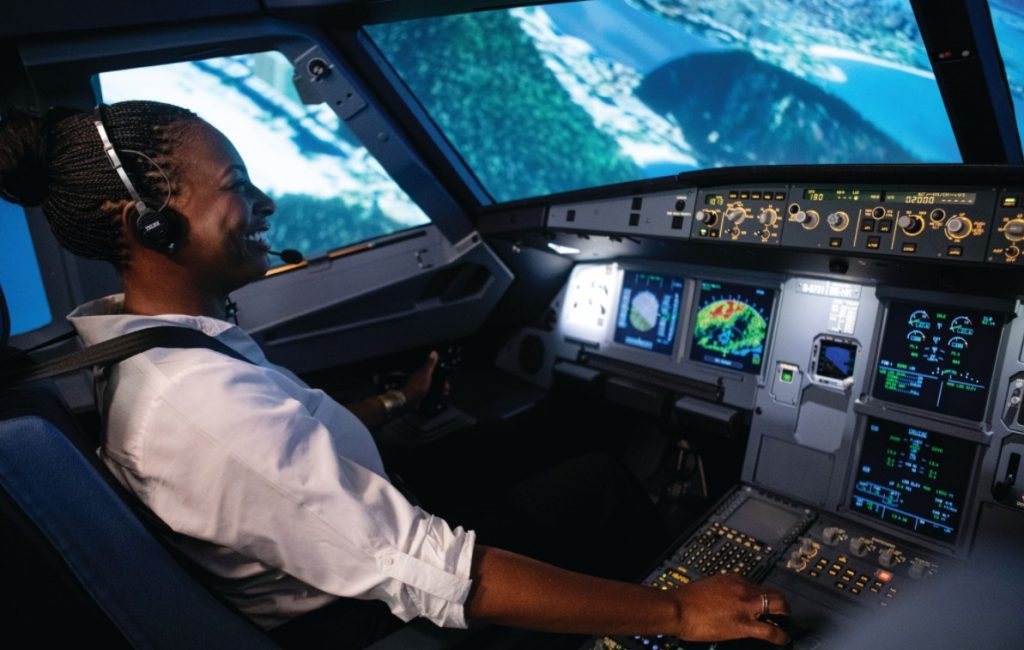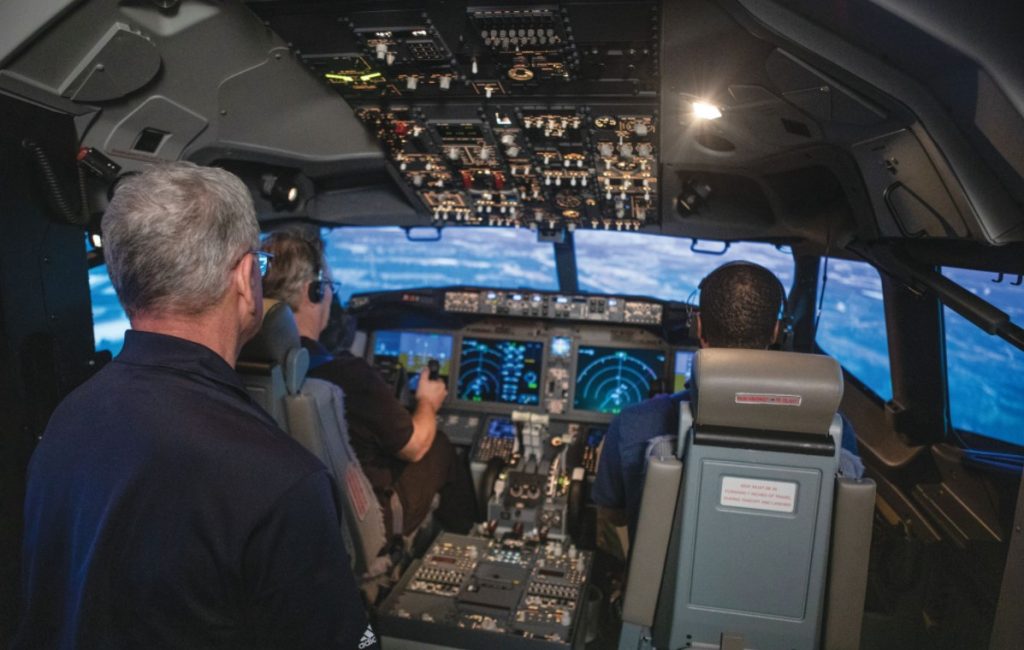FlightSafety International has helped aviation recover from the pandemic and is creating opportunities for commercial airline growth by expanding its line of training simulators and solutions.
Bringing Commercial Air Transport Training to the Forefront
It’s fair to say the landscape has changed dramatically in the past 18 months. As the world grappled with the effects of the COVID-19 pandemic, private and commercial aviation has had to pivot with changing demands, regulations, and procedures. Fortunately, the industry has had a strong partner and innovator.
From assisting flight departments to commercial air transport training, FlightSafety International has helped aviation keep on track and support the growth to come. Powered by technology, innovation and tailored courseware, FlightSafety is providing solutions for aviation’s next challenges.
Responding to Customers’ Needs
FlightSafety didn’t wait for the world to change before creating an expansive catalogue of remote training options. With instructor-led LiveLearning courses and always available eLearning programs, FlightSafety had led the industry in professional online aviation training solutions.
Building on that foundation, FlightSafety worked with the Federal Aviation Administration, the European Union Aviation Safety Agency and the Civil Aviation Safety Authority of Australia to expand its programs – allowing fully authorized options to meet recurrent training requirements for suddenly grounded pilots. These aviation professionals could work to keep ratings current, without having to travel initially for in-person training.
The company helped customers financially affected by the pandemic, offering creative solutions for scheduling and continuing training opportunities. Having worked with regional and international airline customers for more than 30 years, FlightSafety understood that flexibility was greatly needed.
As the industry ramps up again, FlightSafety is proud to serve such operators as SkyWest, Republic, Horizon, PSA, Air Wisconsin, CommutAir, GoJet, Envoy and Mesa within the United States, and J-Air, IBEX, HOP! And PAL Express internationally. It recently announced an extension of its partnership with Canada-based Porter Airlines, serving as the exclusive trainer for its fleet of Embraer E195-E2 and the DHC 8-400. As with other operators, FlightSafety serves Porter conveniently with its nearby Toronto Learning Center.
Specific to Australia, FlightSafety provides pilot and maintenance training support to regional airlines and commercial operators such as the Royal Flying Doctor Service, directly through its system of learning centers or in conjunction with local partners Ansett Aviation Training in Melbourne and Padphen Pty in the Sunshine Coast.
Commercial Air Transport Expansion
FlightSafety has always served commercial air transport (CAT) operators, with strong relationships of major manufacturers for the regional and midsize markets – Embraer, Bombardier (now Mitsubishi Heavy Industries Regional Jet), De Havilland, ATR and Textron Aviation. It has been a valuable partner to support the safe and effective training solutions for these operators, with dedicated airline centres utilizing full flight simulators. FlightSafety’s learning centres are available worldwide, fitting in with airlines’ global demand for qualified and prepared pilots. As U.S-based airline traffic is reaching pre-pandemic levels, FlightSafety has proven to be a key partner in hiring and training demands.
The company is investing in new directions, to accommodate the needs of larger airlines, as well. It recently announced the qualification of its new Airbus A320 and Boeing 737 MAX simulators. These FAA-qualified devices will meet the growing needs of major airlines, who benefit from FlightSafety’s decades of expertise, to train the best-prepared pilots in the sky. The simulators are operational and available for dry leasing in the major air hub of Dallas-Fort Worth and will be available soon in West Palm Beach, Florida.
The A320 simulator incorporates NEO engine configurations that can replicate Pratt & Whitney and CFM LEAP engine types. With the availability for both Thales and Honeywell flight management systems, the A320 simulator enables pilots to train in multiple systems, and are FAA qualified, level D, and feature FlightSafety’s SimVu debriefing system.
The 737 MAX simulator includes 60” electronic motion and control loading which offers the highest level of fidelity and enhanced performance ensuring the highest level of realism. Incorporating the company’s Vital 1150 visual system, FlightSafety’s 737 MAX simulators provide pilots with simulator training that features realistic, detailed high-resolution views designed to enhance safety. In addition to the two pilot seats and the instructor, there are two additional seats in the simulator that can be used for observers or regulatory personnel.
FlightSafety also offers a variety of tailored solutions to CAT operators such as full-turnkey operations including facilities, simulators, courseware, instructors and human resources. Or segmented solutions such as dry-lease arrangements, simulator leasing or simulator sales. FlightSafety’s proven track record of offering customizable solutions answer the needs of large or small operators.
Technology at Forefront of Training
FlightSafety continues to expand its high-tech training offerings to meet the needs of aviation everywhere. Its advances in simulation technology have significantly improved the effectiveness and reduced the cost of training in all phases.
The company is redefining immersive training with Mixed Reality Flight, the next evolution in Extended Reality (XR). XR is an umbrella term encapsulating Augmented Reality (AR), Virtual Reality (VR), Mixed Reality (MR), and everything in between. FlightSafety’s Mixed Reality Flight uses cost-effective technology to merge the real world inside the cockpit with a virtual world outside the window. The pilot is able to see the real-life controls and instruments, as well as charts, notes, or other real-world aids. The real world is then blended with a virtual environment and is integrated with FlightSafety’s VITAL 1150 visual system. This prepares pilots to progress more rapidly through live instruction courseware, training and better utilization of simulator time all of which FlightSafety believes is the most effective training approach in the market.
The MissionFit Interactive Training System is the state-of-the-art, mobile, flight training device engineered to be deployable in virtually any location. MissionFit provides a low-maintenance supplemental training solution that is reconfigurable to many aircraft types. MissionFit utilizes touch-sensitive PlaneGlass technology, presenting a seamless, graphically simulated cockpit without interruptions caused by computer monitor bezels. Digital training material is also accessible using the PlaneGlass technology.
FlightSafety has recently launched new Upset Recovery Training, partnering with Flight Research, an industry leader in advanced pilot training and human spacecraft training. This UPRT course will give pilots the opportunity to experience inflight upset with real gravitational forces, vestibular excitation and mental stress that can only be delivered in a plane; further building upon FlightSafety’s simulation programs that replicate scenarios that cannot be safely accomplished in an aircraft, such as very low-level stall events. Using technology and the aircraft provides the most thorough training possible against loss of in-flight control, the single greatest cause of fatal aviation accidents for more than a decade.
With continuous investment in the infrastructure and technology of training, FlightSafety delivers the courseware, devices and expert instruction that produce an unmatched training environment.

















